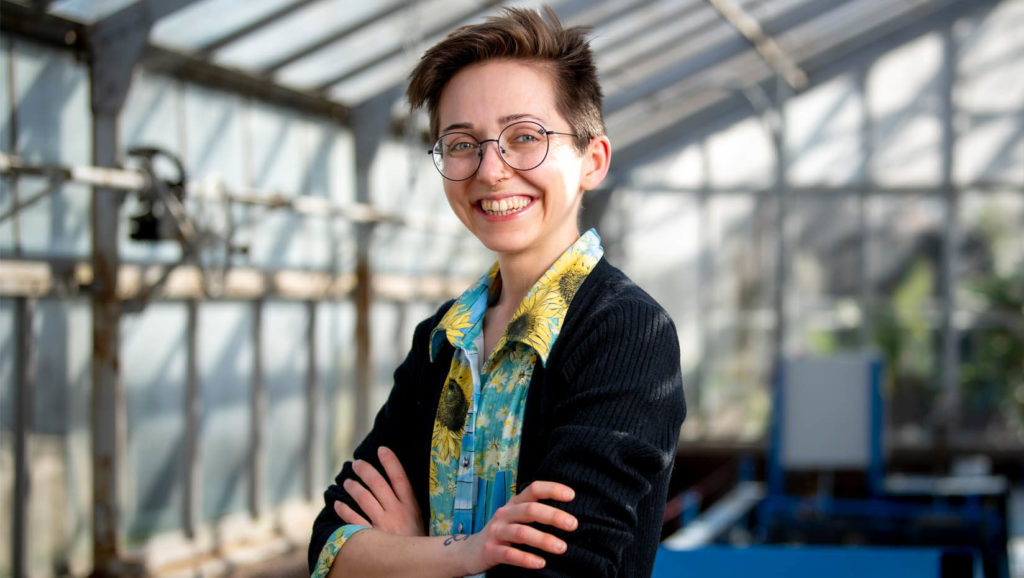Backyard gardeners view weeds as a nuisance to be pulled. They may be viewed even more negatively by the agricultural industry. Uncontrolled weeds on a piece of farmland can damage the crop, preventing it from reaching its full yield and negatively impacting the overall sale price at harvest.
Farmers initially pulled weeds by hand, walking up and down the rows on each field, hunting for any invasive species. This method may have been effective for farmers who were only trying to grow enough food to feed their families. However, as the industry expanded, the areas got larger, and hand-weeding was no longer practical.
Modern agriculture has relied heavily on herbicides — chemicals designed to kill the weeds without damaging the crops. Unfortunately, modern science has painted a clearer picture of these chemicals, discovering the long-term impacts that herbicides can have on human health and local ecosystems. The industry needs a new method for weed control.
Introducing Sonora Ortiz
Sonora Ortiz is a native of Southern California and is no stranger to weeds. Before coming to the University of Maine, they worked on farms in California, as well as throughout Europe, developing a passion for sustainable agriculture. A casual observer might think this would lead Ortiz to a career in agriculture, but when they reached Orono, they chose a physics major.
A weed science class taught by Professor Eric Gallandt — a professor of weed ecology for the School of Food and Agriculture — reignited Ortiz’s passion for agriculture. Gallandt invited them to work with him on a project focusing on manual weed control. It might seem like this team is taking a step backward, returning to older methods. However, Ortiz combines 3D printing and physics to teach a metaphorical old dog some new tricks.
Pulling Weeds with 3D Printing
3D printing has a growing number of applications in nearly every industry, but the agricultural sector has been slower to adopt. So far, the most prominent use there has been prototyping and producing parts for heavy agricultural equipment. The applications may continue to growth the help of researchers like Ortiz, who is combining additive manufacturing with nanotechnology to assist with weed removal in an agricultural setting.
Understanding weeds in the wild can be a challenge. These plants adapt to their environment, so there can be massive variability even within the same species. Good science needs control to remove some of this from the experiment and make it easier to draw accurate conclusions about weed removal methods.
3D printing is much more efficient for testing methods of physical weed removal. This involves pulling the plants from the ground, roots and all, instead of treating them with herbicide. Previous research techniques relied on rods as weed substitutes, which provided a control in experimentation but didn’t behave like a living plant, with a root system. The alternative was the use of actual weeds grown in soil specifically for such testing.
The problem with the latter was that ,once the test was complete, it was unrepeatable. Researchers were stuck waiting for the next batch of weeds to grow, and there was no guarantee that each new plant would be identical to the last.
3D printing, combined with nanotechnology, addresses both of those problems. Researchers like Ortiz can print a test weed with a root system and use that same printed plant repeatedly. Nanocoatings, applied by simply dipping the artificial roots in the coating solution, work to mimic the root hairs that can cling to soil and make it more difficult to remove the entire plant.
The science behind these physical weed removal tests goes back to beam-bending physics. How hard can they pull before the roots snap, leaving plant material in the ground to regrow into a new weed? These “force curves” allow researchers to understand how each plant clings to the soil, making it easier to remove them without the need for harsh herbicides or other chemicals that could damage surrounding plants.
The Future of 3D Printed Weed Pulling
With a new grant, Ortiz will be able to further their research into weed science. Specifically, they will be working with Bashir Khoda, assistant professor of mechanical engineering, to create nanocoatings that actually orient molecules on 3D printed roots to even more accurately replicate the force of hairs on roots. The grant will also allow Ortiz to attend the Weed Society of America annual conference to present their findings. In the long run, Ortiz aims to apply 3D printing techniques to a wide variety of crops to optimize weed control such that weed removal doesn’t damage surrounding crops.
Feature image courtesy of Mississippi Watershed Management Organization.
Subscribe to Our Email Newsletter
Stay up-to-date on all the latest news from the 3D printing industry and receive information and offers from third party vendors.
Print Services
Upload your 3D Models and get them printed quickly and efficiently.
You May Also Like
Josh Makeshift and the New Gold Standard 3D Printing Content Creation
In the beginning, 2007 or so, 3D printing videos were almost wholly absent from the web. Then, here and there, makers started to upload pictures of their rickety RepRaps and...
Making Space: Stratasys Global Director of Aerospace & Defense Conrad Smith Discusses the Space Supply Chain Council
Of all the many verticals that have been significant additive manufacturing (AM) adopters, few have been more deeply influenced by the incorporation of AM into their workflows than the space...
EOS in India: AM’s Rising Star
EOS is doubling down on India. With a growing base of aerospace startups, new government policies, and a massive engineering workforce, India is quickly becoming one of the most important...
A 3D Printed Lab Tool for Space Biology Survives Spaceflight
When it comes to space missions, even the smallest tools have to be light, tough, and reliable, and one small device is proving just how powerful that combination can be....

































